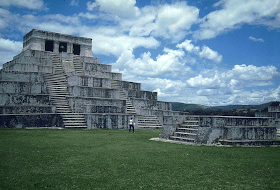Today, I wouldn't like to sound to academic; however, please keep in mind that my only reference to guide us during this visit are academic documents, starting with a 2007 document published by Patricia del Aguila of the Department of Anthropological, Archaeological and Historical Research of Guatemala, the book Ciudades Sagradas Mayas (Mayan Sacred Cities) published by Fundacion G&T Continental, and some other publications, Zaculeu, the ancient capital of the Mam Maya Group, contains several temples and structures, which show some architectural influence of the Mexican highlands, particularly from Teotihuacan.
The structures that can be seen today, date back to the Maya Post Classic Period, although the original settlement goes back to the Century V BC. There is evidence indicating that Zaculeu reached its maximum splendor between 1250 and 1524 AC, when the city was occupied by the Spaniards.
Zaculeu lies on a 4,000 sq m plateau in the mountain range Los Cuchumatanes (a Mam voice that translates as "that, which was brought together by superior force") at an altitude of almost 2,000m (6,200ft), overlooking the Selegua river, flanked by deep ravines, with one only access on the north side. Additionally, the original city was fortified, which suggests a defensive position.
Artifacts recovered from the site include items fashioned from turquoise and metal artifacts crafted from gold, silver and copper and their alloys demonstrating the city's participation in the wider trade networks of the Postclassic Period, according to the chart suggested by Christopher Jones in 1993.
These metal artifacts were either influenced by or imported from Mexico and southern Central and South America.
These metal artifacts were either influenced by or imported from Mexico and southern Central and South America.
The impressive and almost intact ball-court consists of the structures marked as 22 and 23, was used for the ceremonial Meso American ballgame.
It is an I-shaped sunken ball-court with sloping walls. The two structures forming the sides of the ball-court once supported buildings, now only the lower sections of their walls remain. The ball-court is oriented northwest to southeast and is 48 m (157 ft) long.
So far, let me tell you that I am impressed! Without any doubt, this place will be included in my next trip to Guatemala.
It is an I-shaped sunken ball-court with sloping walls. The two structures forming the sides of the ball-court once supported buildings, now only the lower sections of their walls remain. The ball-court is oriented northwest to southeast and is 48 m (157 ft) long.
So far, let me tell you that I am impressed! Without any doubt, this place will be included in my next trip to Guatemala.






No comments:
Post a Comment
Thanks for your comments. I appreciate your feedback!